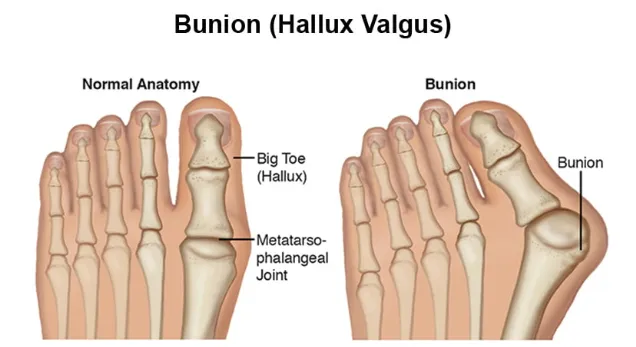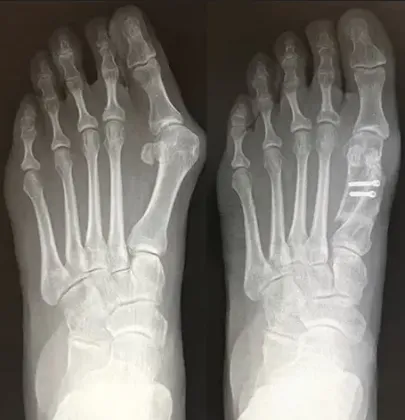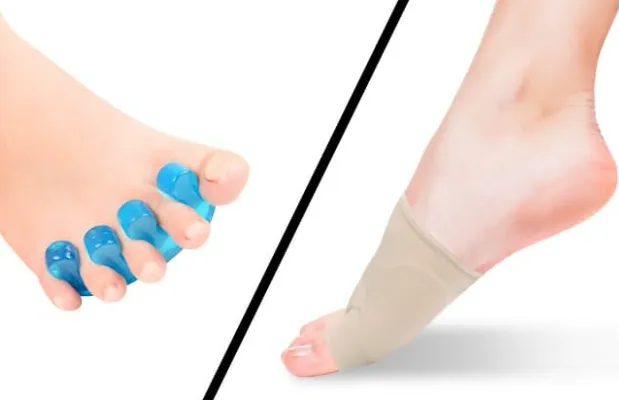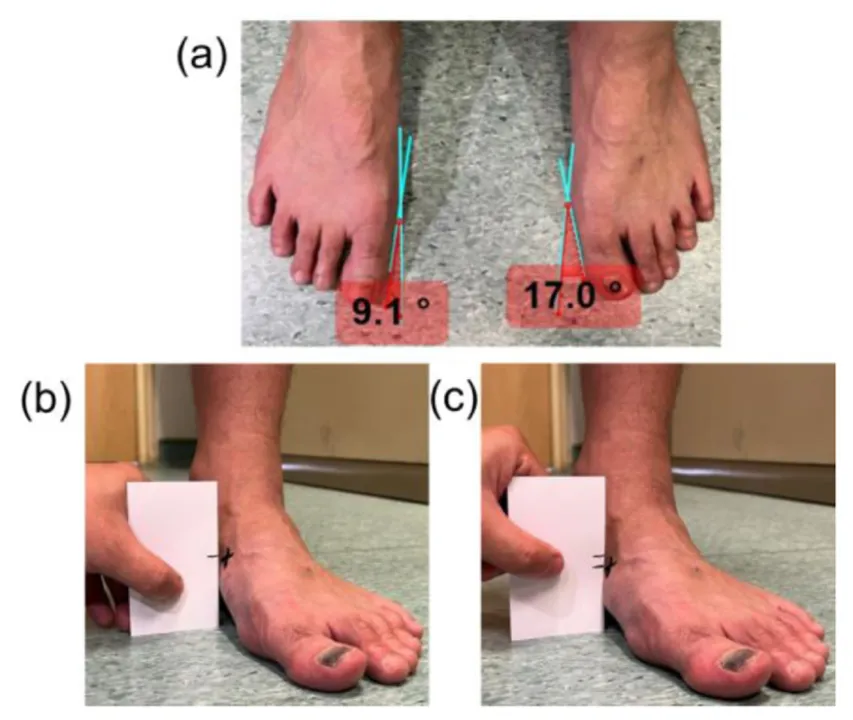Toe Spacers for Bunions: The Complete Evidence-Based Guide
Toe Spacers for Bunions: The Complete Evidence-Based Guide
If you're dealing with that painful, bony bump on your big toe, you've probably wondered: "Can toe spacers actually help my bunion?" The answer is more nuanced than most marketing claims suggest—but also more hopeful than many people realize.

What Exactly IS a Bunion?
Before diving into solutions, let's get crystal clear on what we're dealing with. A bunion (medical term: hallux valgus) isn't just a "bump" that appeared overnight—it's a progressive structural deformity involving your entire foot mechanics.
Here's what's actually happening:
- Your first metatarsal bone starts deviating inward toward your other foot
- Your big toe (hallux) simultaneously deviates outward toward your smaller toes
- This creates that characteristic "bump" at the joint where your big toe meets your foot
🔍 Think of It This Way: Imagine a door slowly coming off its hinges. The "bump" is just the visible sign of the underlying joint misalignment—not the problem itself.
Why Bunions Develop
Most bunions aren't genetic destiny—they're the result of years of mechanical stress from footwear that forces your toes into unnatural positions. That narrow, pointed toe box we discussed in our foundational article about how modern shoes damage feet? This is where the damage shows up most dramatically.
The progression is usually slow but relentless, which is why bunions are more common as we age and why they're significantly more prevalent in cultures that wear constrictive footwear.
The Research on Toe Spacers for Bunions: What We Know for Sure
When it comes to bunions, toe spacers have been studied more extensively than for any other condition. Here's what the science actually shows, building on the comprehensive research analysis we've covered.
The Pain Relief Evidence: Solid and Consistent
Multiple systematic reviews consistently identify toe spacers as valuable for bunion management. The evidence for pain reduction is robust and reproducible.
A landmark 2008 comparative study provided crucial insights:
- Patients with bunions used toe spacers for three months
- They experienced significant reduction in pain intensity
- The pain relief was measurable and meaningful to patients' daily lives
✅ Bottom Line: If you're looking for bunion pain relief, toe spacers have solid scientific backing. This isn't wishful thinking—it's documented, peer-reviewed evidence.
The Structural Reality: Managing Expectations

Now for the plot twist that changes everything: that same 2008 study found no statistically significant reduction in the hallux valgus angle (the measurement of how severely the toe is deviated).
Translation: The spacers made people feel dramatically better without actually "fixing" the bone deformity.
This finding is absolutely crucial for setting realistic expectations. Toe spacers are not performing invisible orthopedic surgery on your foot.
🎯 Key Insight: Toe spacers address the functional problems caused by bunions (pain, pressure, altered mechanics) without necessarily correcting the structural deformity (bone and joint misalignment).
The "Permanent Fix" Myth: What Podiatric Surgeons Want You to Know
Here's where we need to burst a major bubble perpetuated by marketing materials.
The Surgical Reality
Podiatric surgeons are unanimous on this point: toe spacers cannot permanently "cure" or reverse a structural bunion deformity. The only definitive method for correcting the underlying joint malalignment is surgery.
This doesn't make toe spacers useless—it just means we need to understand what they can and can't do.
Temporary vs. Lasting Changes
While wearing toe spacers, your toe alignment may visibly improve. This can be encouraging and certainly helps with comfort. However, this benefit is typically lost soon after removing the device.
Think of it like wearing glasses—they improve your vision while you're wearing them, but they don't permanently cure your eyesight.
⚠️ Reality Check: Those compelling "before and after" photos in advertisements? They're likely showing the temporary improvement that occurs while wearing the spacers, not permanent structural change.
The Game-Changer: The Exercise + Spacer Combination
Here's where the research gets really exciting and offers genuine hope for lasting improvement.
The Synergy Discovery
Network meta-analyses (studies that compare multiple treatments simultaneously) revealed something significant: a combination of exercise and toe spacers was among the most effective non-surgical interventions for achieving measurable reduction in both hallux valgus angle and intermetatarsal angle.
This finding is revolutionary because it suggests toe spacers might not work as a passive, standalone device, but rather as an enhancer for active rehabilitation.
This is exactly why building a comprehensive foot health program that includes targeted exercises is so crucial for optimal results.
How the Combination Works
The theory makes beautiful biomechanical sense:
- Toe spacers create optimal positioning by gently encouraging toe separation
- Exercises strengthen the weakened muscles that should be pulling your big toe back into proper alignment
- The spacer provides a better mechanical advantage for those muscles to work effectively
- Active movement under load (while wearing spacers during activities) may promote lasting tissue adaptation
💡 The Synergy Effect: Imagine trying to strengthen a muscle that's constantly in a cramped position versus one that's properly aligned. The spacer creates the alignment; the exercises create the strength.
Reframing the Question
This research shifts the conversation from "Do toe spacers work?" to "How do toe spacers work best?" The answer appears to be: as an adjunct to active rehabilitation, not as a replacement for it.
Post-Surgery: Where Spacers Shine
Toe spacers have a well-established and important role after bunion correction surgery.
The Healing Support Role
Following surgical correction, toe spacers are commonly recommended for several months to:
- Maintain the corrected toe position during the crucial healing period
- Prevent the toe from drifting back toward its deformed position
- Support the surgeon's work by providing gentle, consistent positioning
In this context, toe spacers are like a "cast" for your toe alignment—supporting the healing process rather than trying to create change on their own.
🏥 Medical Context: Post-surgical use of toe spacers isn't experimental—it's standard practice supported by orthopedic principles and clinical experience.
Understanding the Conservative Treatment Hierarchy

It's important to understand where toe spacers fit in the overall approach to bunion management.
The Conservative Pyramid
Level 1: Symptom Management (Most Important)
- Appropriate footwear with wide toe boxes
- Toe spacers for pain and pressure relief
- Cushioning pads and protective devices
Level 2: Active Intervention
- Targeted strengthening exercises
- Stretching and mobility work
- Toe spacers + exercise combinations
Level 3: Professional Support
- Custom orthotics for biomechanical correction
- Physical therapy programs
- Professional gait analysis
Level 4: Surgical Consideration
- For severe deformities causing significant functional limitation
- When conservative measures aren't providing adequate relief
📊 Success Strategy: Most people benefit from combining multiple levels rather than relying on any single intervention.
Comparing Spacers to Other Conservative Options
Research has compared toe spacers to other non-surgical treatments, providing valuable context.
Spacers vs. Custom Orthotics
One study found that custom insoles were more effective than toe separators at reducing plantar pressure in the forefoot in patients with hallux valgus. This suggests custom orthotics might have a more powerful biomechanical effect for certain goals.
However, this doesn't make spacers inferior—it highlights that different tools serve different purposes:
- Custom orthotics: Better for overall pressure redistribution and biomechanical control
- Toe spacers: Better for direct toe alignment and interdigital pressure relief
The Complete Conservative Toolkit
Other evidence-based conservative options include:
- Night splints that hold the toe in corrected position during sleep
- Bunion shields for cushioning and protection
- Gel pads for pressure relief over the bunion prominence
- Targeted exercise programs for muscle strengthening and joint mobility
🛠️ Tool Selection: The best approach often involves selecting the right combination of tools based on your specific symptoms and functional limitations.
Practical Guidelines: Making Spacers Work for Your Bunion

Based on the research, here's how to optimize toe spacer use for bunions:
Realistic Goal Setting
✅ Appropriate expectations:
- Significant pain reduction during use
- Improved comfort in properly fitting shoes
- Better toe mechanics during activities
- Potential enhancement of exercise effectiveness
❌ Unrealistic expectations:
- Permanent structural reversal of the deformity
- Elimination of the bunion "bump"
- Avoiding surgery in severe cases
- Overnight transformation
Usage Strategy
For Pain Management:
- Start with short wearing periods (30 minutes) and build gradually
- Use during activities that typically cause bunion pain
- Combine with appropriate footwear that accommodates both foot and spacer
For Exercise Enhancement:
- Wear during targeted foot strengthening exercises
- Use during balance and proprioception training
- Consider active use during low-impact weight-bearing activities
⏰ Timing Matters: The research suggesting structural benefits comes from studies using spacers in combination with exercises over extended periods (typically 3+ months of consistent use).
When you're ready to select specific products, our evidence-based toe spacer recommendations can help you choose options that align with research findings for bunion management.
When to Consider Professional Help
While toe spacers are generally safe for bunions, certain situations warrant professional consultation:
Red Flags for Immediate Consultation
- Sudden worsening of bunion pain or deformity
- Signs of infection (redness, warmth, swelling around the bunion)
- Nerve symptoms (numbness, tingling in the toe)
- Functional limitation that interferes with daily activities
Optimal Timing for Professional Evaluation
- Early-stage bunions: To learn proper exercise techniques and get fitted for appropriate spacers
- Moderate bunions: To explore custom orthotic options and comprehensive treatment plans
- Severe bunions: To discuss surgical options and timing
👩⚕️ Professional Advantage: A podiatrist can determine whether your bunion is flexible (potentially more responsive to conservative care) or rigid (may require different strategies).
The Bottom Line on Toe Spacers for Bunions
The research paints a clear picture: toe spacers are a legitimate, evidence-based tool for bunion management—but they're not a miracle cure.
Their greatest strength lies in pain reduction and functional improvement, particularly when combined with appropriate exercises and footwear modifications. The possibility of some structural improvement exists when spacers are used as part of a comprehensive, active rehabilitation program.
Most importantly, toe spacers buy you time and comfort while you address the underlying factors that caused your bunion in the first place—namely, years of wearing inappropriate footwear.
🎯 The Smart Strategy: Use toe spacers as part of a comprehensive foot health plan, not as a standalone solution. They're most effective when combined with proper shoes, targeted exercises, and realistic expectations.
Next up: We're going to tackle the biggest myths surrounding toe spacers—from "permanent correction" claims to athletic performance promises. Time to separate marketing fiction from scientific fact.
Important Note: This information is based on peer-reviewed research but doesn't replace professional medical advice. Bunions can vary significantly in severity and underlying causes. Always consult with a podiatrist for persistent pain or rapidly worsening deformities.
Comments
Post a Comment